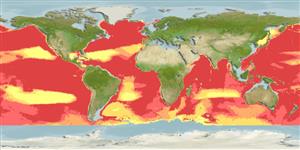分类 / Names
俗名 | 同种异名 | Catalog of Fishes(属, 种) | ITIS | CoL | WoRMS | Cloffa
Teleostei >
Lophiiformes (Anglerfishes) >
Ceratiidae (Warty Seadevils)
Etymology: Ceratias: Greek, keras = horn or horned, refers to the lure projecting from the snout (Ref. 86949).
Eponymy: Henrik Nikolai Krøyer (1799–1870) was a Danish marine biologist. [...] (Ref. 128868), visit book page.
Environment: milieu / climate zone / depth range / distribution range
生态学
海洋 深海区的; 深度上下限 400 - 4400 m (Ref. 74511), usually 400 - 2000 m (Ref. 37729). 深水域; 67°N - 45°S, 180°W - 180°E
Circumglobal: In tropical to temperate waters. Adults (expatriates ?) found in boreal and subarctic waters. South China Sea and East China Sea (Ref.74511).
所有的海洋。 成魚 (遊離棲地 ?) 發現於北與靠近北極的水域了。
大小 / 重量 / 年龄
Maturity: Lm ? range ? - ? cm
Max length : 16.0 cm SL 雄鱼/尚未辨别雌雄; (Ref. 7463); 120.0 cm TL (female); common length :77 cm TL (female)
背棘 (总数) : 1; 背的软条 (总数) : 3 - 4; 臀棘: 0; 臀鳍软条: 4; 脊椎骨: 20. Branchiostegal rays: 6 (Ref. 36494).
鳃条骨: 6.(参考文献 36494)
Maximum size observed for free living males is 1.3 cm (Ref. 10524). Males are parasitic, females oviparous with planktonic larvae (Ref. 36494). Eggs are presumably contained in floating gelatinous rafts (Ref. 36494). Minimum depth from Ref. 037729.
给自由生活的雄鱼观察到的最大体长是 1.3 公分。 (参考文献 10524) 雄性是寄生的, 雌性卵生的仔鱼为浮游性.(参考文献 36494) 卵是可能包覆在漂浮的凝胶状的筏中.(参考文献 36494)
Life cycle and mating behavior
成熟度 | 繁殖 | 产卵场 | 卵 | 孕卵数 | 仔鱼
Oviparous (Ref. 36494).所有的海洋。 成魚 (遊離棲地 ?) 發現於北與靠近北極的水域了。
Bertelsen, E., 1990. Ceratiidae. p. 510-512. In J.C. Quero, J.C. Hureau, C. Karrer, A. Post and L. Saldanha (eds.) Check-list of the fishes of the eastern tropical Atlantic (CLOFETA). JNICT, Lisbon; SEI, Paris; and UNESCO, Paris. Vol. 1. (Ref. 4494)
世界自然保护联盟红皮书 (Ref. 130435: Version 2024-1)
人类利用
渔业: 没有兴趣
工具
特别资料
下载 XML
网络资源
Estimates based on models
Preferred temperature (Ref.
123201): 2 - 9.7, mean 3.8 °C (based on 7133 cells).
Phylogenetic diversity index (Ref.
82804): PD
50 = 0.6875 [Uniqueness, from 0.5 = low to 2.0 = high].
Bayesian length-weight: a=0.01995 (0.00906 - 0.04395), b=3.01 (2.83 - 3.19), in cm total length, based on all LWR estimates for this body shape (Ref.
93245).
营养阶层 (Ref.
69278): 3.2 ±0.40 se; based on food items.
Fishing Vulnerability (Ref.
59153): High to very high vulnerability (72 of 100).
